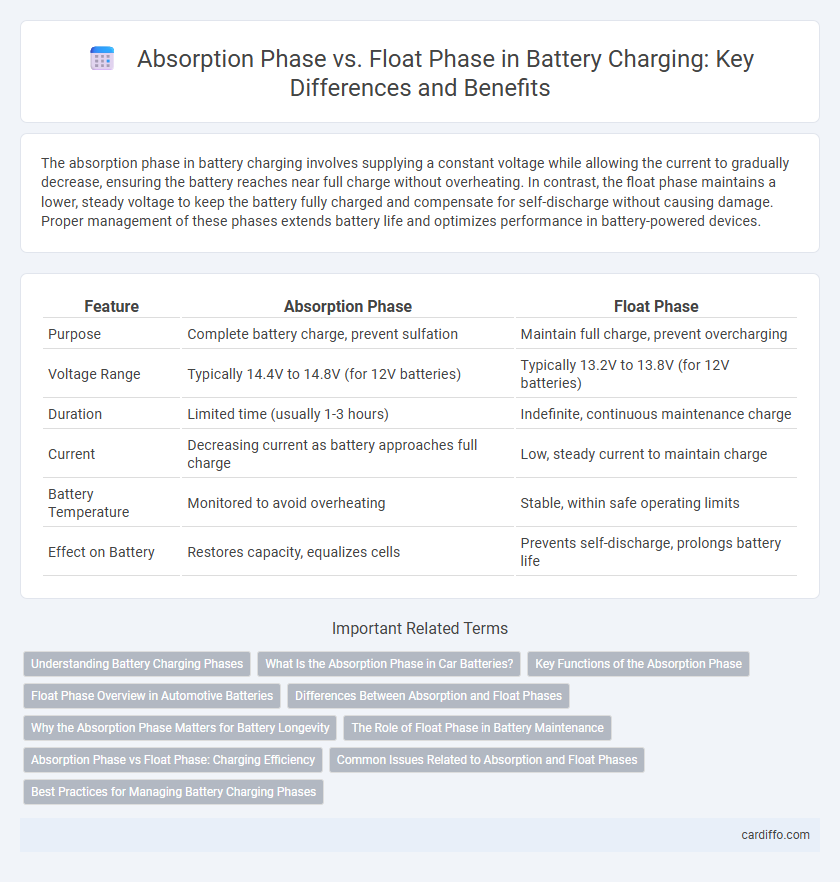The absorption phase in battery charging involves supplying a constant voltage while allowing the current to gradually decrease, ensuring the battery reaches near full charge without overheating. In contrast, the float phase maintains a lower, steady voltage to keep the battery fully charged and compensate for self-discharge without causing damage. Proper management of these phases extends battery life and optimizes performance in battery-powered devices.
Table of Comparison
| Feature | Absorption Phase | Float Phase |
|---|---|---|
| Purpose | Complete battery charge, prevent sulfation | Maintain full charge, prevent overcharging |
| Voltage Range | Typically 14.4V to 14.8V (for 12V batteries) | Typically 13.2V to 13.8V (for 12V batteries) |
| Duration | Limited time (usually 1-3 hours) | Indefinite, continuous maintenance charge |
| Current | Decreasing current as battery approaches full charge | Low, steady current to maintain charge |
| Battery Temperature | Monitored to avoid overheating | Stable, within safe operating limits |
| Effect on Battery | Restores capacity, equalizes cells | Prevents self-discharge, prolongs battery life |
Understanding Battery Charging Phases
The absorption phase of battery charging involves applying a constant voltage to gradually bring the battery to full charge while limiting current to avoid overheating. The float phase maintains the battery at a lower, steady voltage to preserve full charge without causing overcharging or damage. Understanding these distinct phases ensures optimal battery longevity and efficient energy storage.
What Is the Absorption Phase in Car Batteries?
The absorption phase in car batteries refers to the stage of charging where the voltage is held constant while the current gradually decreases to fully charge the battery without overcharging. During this phase, the battery absorbs energy efficiently, restoring its capacity by replenishing the active material inside the cells. Maintaining the correct voltage during absorption is crucial to prevent overheating and prolong battery life.
Key Functions of the Absorption Phase
The Absorption Phase plays a crucial role in battery charging by holding the voltage constant while current gradually decreases to prevent overcharging and ensure full capacity. This phase allows the battery to complete the chemical reactions needed to maximize energy storage and balance cell voltages effectively. Maintaining precise voltage levels during absorption helps avoid thermal stress and prolongs battery lifespan.
Float Phase Overview in Automotive Batteries
The float phase in automotive batteries maintains a consistent voltage level to keep the battery fully charged without causing overcharging or damage. During this phase, the battery charger supplies a reduced voltage, typically around 13.2 to 13.8 volts for a 12-volt battery, ensuring the electrolyte remains stable and minimizing water loss. Proper management of the float phase extends battery life and ensures reliable performance in vehicle electrical systems.
Differences Between Absorption and Float Phases
The absorption phase involves charging the battery at a constant voltage, allowing the current to gradually decrease as the battery reaches full charge, which helps prevent overheating and overcharging. In contrast, the float phase maintains a lower, steady voltage to keep the battery fully charged without causing excessive gassing or damage, extending battery life and ensuring readiness. The key difference lies in absorption addressing rapid charge completion, while float focuses on long-term maintenance and battery preservation.
Why the Absorption Phase Matters for Battery Longevity
The absorption phase is critical for battery longevity because it ensures the battery reaches full charge without overcharging, which prevents excessive gassing and plate corrosion. During this phase, the voltage is held constant while current gradually decreases, allowing active materials within the battery to fully saturate. Unlike the float phase that maintains a lower voltage to compensate for self-discharge, the absorption phase maximizes capacity and chemical stability, extending overall battery life.
The Role of Float Phase in Battery Maintenance
The float phase in battery maintenance ensures the battery remains at full charge without overcharging, preserving battery life and performance. During this phase, a constant voltage is applied at a lower current, compensating for self-discharge and preventing electrolyte depletion. Proper management of the float phase is critical for sealed lead-acid and VRLA batteries to avoid corrosion and extend overall battery service life.
Absorption Phase vs Float Phase: Charging Efficiency
The absorption phase delivers a constant voltage to the battery, maximizing charging efficiency by rapidly replenishing the battery's capacity without causing overcharge. In contrast, the float phase maintains a lower, steady voltage to keep the battery fully charged while minimizing energy loss and preventing degradation. Optimizing the transition between absorption and float phases ensures prolonged battery lifespan and improved overall energy efficiency.
Common Issues Related to Absorption and Float Phases
Common issues during the absorption phase include overcharging, which can cause excessive heat and water loss in lead-acid batteries, reducing overall battery lifespan. In the float phase, problems often arise from improper voltage settings that lead to undercharging or sulfation, ultimately diminishing battery capacity and performance. Maintaining accurate voltage regulation and temperature compensation is essential to prevent these absorption and float phase complications and ensure optimal battery health.
Best Practices for Managing Battery Charging Phases
During the absorption phase, the battery is charged at a constant voltage with decreasing current to ensure maximum energy absorption without overcharging. The float phase maintains the battery at a lower, steady voltage to compensate for self-discharge and prevent damage from overcharging. Best practices include carefully monitoring voltage and temperature to optimize charging efficiency and prolong battery lifespan.
Absorption Phase vs Float Phase Infographic

 cardiffo.com
cardiffo.com